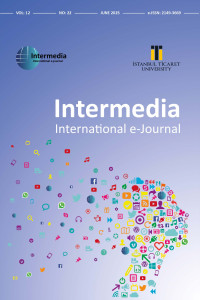Abstract
Küreselleşme, yeni iletişim teknolojilerinin aşırı hızda gelişmesi ve kuruluşların hesap verebilir ve şeffaf olma zorunluluğu, iletişimin yanı sıra tüm alanlarda değişimi zorunlu kılmıştır. Paydaş güçlendirme yapısının önem kazanması nedeniyle, paydaşların ihtiyaç ve tercihlerine yönelik ilgi artmış olup, bu bazı uygulayıcılar tarafından bir devrim olarak kabul edilmiştir. Dijitalleşen dünya, şirketler için önemli araçlardan ve varlıklardan biri olan iletişim yönetimini değiştiriyor ve dönüştürüyor. Bu kapsamda, bu makalede kurumsal iletişim açısından öne çıkan yönetim stratejileri ele alınacaktır.
References
- Anderson, C. (2007). The long tail: How endless choice is creating unlimited demand (Updated and expanded ed.). London: Random House Business Books.
- Argenti, P. A. & Barnes, C. M. (2009). Digital strategies for powerful corporate communications. London: McGraw Hill.
- Artut, S. (2014). Teknoloji-insan birlikteliği [Technology-human cooperation]. İstanbul: Ayrıntı Yayınları.
- Atikkan, T. & Tunç, A. (2011). Blogdan al haberi [Get news from the blog]. İstanbul: YKY Publicatons.
- Bauman, Z. (1998). Globalization: the human consequences. Cambridge: Polity Press.
- Bauman, Z. V. & Lyon, D. (2013). Liquid surveillance. Cambridge: Polity Press.
- Castells, M. (1997). The rise of the network society. USA: Blackwell Publishers.
- Dijk, J.V. (2016). The network society. London: SAGE Publications. 2nd Edition.
- Erdoğan, I. (2013). Dördüncü güç medyadan beşinci güç internete: demokratik bir dönüşüm mü yaşanıyor? [From fourth estate media to fifth estate internet: Is being a democratic transformation happening?] Selçuk İletişim, 8 (1): 176–191.
- Freeman, R. E. (1984). Strategic management: A stakeholder approach. Cambridge: Cambridge University Press.
- Friedman, T. L. (2006). The world is flat. İstanbul: Penguin Books.
- Gürsakal, N. (2013). Büyük veri [Big data]. Bursa: Dora Publications. Hartley, P. & Chatterton, P. (2015). Business communication: Rethinking your Professional practice for the post digital age. London: Routledge.
- Hynes, G.E. (2016). Managerial communication, strategies and applications. USA: Sage Publications.
- Howe, J. (2008). Crowdsourcing: Why the power of the crowd is driving the future of business, https://dl.acm.org/citation.cfm?id=1481457
- Jenkins, H. (2016). Convergence culture: Where old and new media collide. New York: New York University Press.
- Kahraman, M. (2014). Sosyal Medya 101 2.0 [Social media 101 2.0]. İstanbul: Mediacat Publications.
- Keçecioğlu, T. (2003). Stratejik insan kaynakları yönetimi [Strategic human resource management]. İstanbul: Sistem Publications.
- Laughey, D. (2010). Medya çalışmaları teoriler ve yaklaşımlar. İstanbul: Kalkedon Publications.
- Livingstone, S. (1999). New Media, new audiences? New Media & Society, 1(1): 59–66.
- Silverstone, R. (1999). What's new about new media? New Media & Society, 1(1):10-82.
- Timisi, N. (2003). Yeni iletişim teknolojileri ve demokrasi [New communication Technologies and democracy]. Ankara: Dost Publications.
- Toffler, A. (2008). The third wave. William Morrow & Company. Tomlinson, J. (1999). Globalization and culture. Cambridge: Polity Press.
Abstract
Globalisation, development of new communication technologies at hypervelocity and the necessity of organisations to be accountable and transparent has compelled the change in all areas as well as communication. Due to the gaining importance of stakeholder empowerment construct, the consideration towards stakeholders' needs and preferences has increased, which is considered as a revolution by some practitioners. Digitalizing world has been changing and converting communication management, which is one of the crucial tools and assets for corporations. Within this scope, prominent management strategies in terms of corporate communication will be discussed in this article.
References
- Anderson, C. (2007). The long tail: How endless choice is creating unlimited demand (Updated and expanded ed.). London: Random House Business Books.
- Argenti, P. A. & Barnes, C. M. (2009). Digital strategies for powerful corporate communications. London: McGraw Hill.
- Artut, S. (2014). Teknoloji-insan birlikteliği [Technology-human cooperation]. İstanbul: Ayrıntı Yayınları.
- Atikkan, T. & Tunç, A. (2011). Blogdan al haberi [Get news from the blog]. İstanbul: YKY Publicatons.
- Bauman, Z. (1998). Globalization: the human consequences. Cambridge: Polity Press.
- Bauman, Z. V. & Lyon, D. (2013). Liquid surveillance. Cambridge: Polity Press.
- Castells, M. (1997). The rise of the network society. USA: Blackwell Publishers.
- Dijk, J.V. (2016). The network society. London: SAGE Publications. 2nd Edition.
- Erdoğan, I. (2013). Dördüncü güç medyadan beşinci güç internete: demokratik bir dönüşüm mü yaşanıyor? [From fourth estate media to fifth estate internet: Is being a democratic transformation happening?] Selçuk İletişim, 8 (1): 176–191.
- Freeman, R. E. (1984). Strategic management: A stakeholder approach. Cambridge: Cambridge University Press.
- Friedman, T. L. (2006). The world is flat. İstanbul: Penguin Books.
- Gürsakal, N. (2013). Büyük veri [Big data]. Bursa: Dora Publications. Hartley, P. & Chatterton, P. (2015). Business communication: Rethinking your Professional practice for the post digital age. London: Routledge.
- Hynes, G.E. (2016). Managerial communication, strategies and applications. USA: Sage Publications.
- Howe, J. (2008). Crowdsourcing: Why the power of the crowd is driving the future of business, https://dl.acm.org/citation.cfm?id=1481457
- Jenkins, H. (2016). Convergence culture: Where old and new media collide. New York: New York University Press.
- Kahraman, M. (2014). Sosyal Medya 101 2.0 [Social media 101 2.0]. İstanbul: Mediacat Publications.
- Keçecioğlu, T. (2003). Stratejik insan kaynakları yönetimi [Strategic human resource management]. İstanbul: Sistem Publications.
- Laughey, D. (2010). Medya çalışmaları teoriler ve yaklaşımlar. İstanbul: Kalkedon Publications.
- Livingstone, S. (1999). New Media, new audiences? New Media & Society, 1(1): 59–66.
- Silverstone, R. (1999). What's new about new media? New Media & Society, 1(1):10-82.
- Timisi, N. (2003). Yeni iletişim teknolojileri ve demokrasi [New communication Technologies and democracy]. Ankara: Dost Publications.
- Toffler, A. (2008). The third wave. William Morrow & Company. Tomlinson, J. (1999). Globalization and culture. Cambridge: Polity Press.
Details
| Primary Language | English |
|---|---|
| Subjects | Communication Studies |
| Journal Section | Articles |
| Authors | |
| Early Pub Date | June 29, 2025 |
| Publication Date | June 30, 2025 |
| Submission Date | January 6, 2025 |
| Acceptance Date | February 20, 2025 |
| Published in Issue | Year 2025 Volume: 12 Issue: 22 |
 Intermedia International E-journal
Intermedia International E-journal
Bu eser Creative Commons Alıntı-GayriTicari-Türetilemez 4.0 Uluslararası Lisansı ile lisanslanmıştır.


